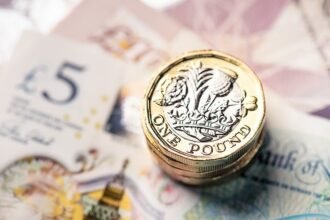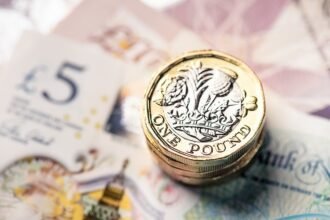- The Pound Sterling recovers to near 1.2930 against a pressured US Dollar amid US economic uncertainty.
- Investors have become increasingly confident that the US economy could enter a recession.
- UK PM Starmer vows to shelter domestic firms from potential global trade war.
The Pound Sterling (GBP) bounces back to near 1.2930 against the US Dollar (USD) in Monday’s European session after hitting a one-month low of 1.2830 earlier in the day. The GBP/USD pair attracts bids as the US Dollar faces pressure due to the imposition of reciprocal tariffs by United States (US) President Donald Trump on Wednesday. The US Dollar Index (DXY), which tracks the Greenback’s value against six major currencies, declines to near 102.40.
Financial market participants have become increasingly concerned over the US economic outlook as Federal Reserve (Fed) Chair Jerome Powell stated on Friday that larger-than-expected tariffs announced by the President could lead to a resurgence in inflation and slower economic growth. “We face a highly uncertain outlook with elevated risks of both higher unemployment and higher inflation,” Powell said in his prepared remarks at the annual conference for the Society for Advancing Business Editing and Writing.
When asked about the impact of Trump’s tariffs on the monetary policy outlook, Powell continued with the “wait and see” approach and said, “The Fed is well-positioned to wait for greater clarity before considering policy adjustments.”
Meanwhile, market experts now see a greater chance that Trump’s sweeping, harsh-than-expected tariffs on US trading partners could push the US economy into a recession. Investment banking firms Goldman Sachs and JP Morgan have raised the probability of the US entering a recession to 45% and 60%, respectively.
This week, investors will focus on the US Consumer Price Index (CPI) data for March, which will be released on Thursday. The impact of the US CPI data is expected to be limited in the US Dollar unless there is a dramatic change, as market expectations for the Fed’s monetary policy outlook will likely be driven by tariff-led consumer inflation expectations.
Daily digest market movers: Pound Sterling demonstrates high volatility
- The Pound Sterling exhibits highly volatile action against its peers at the start of the week. The British currency is impacted by Trump’s tariffs-driven uncertainty that is expected to batter the United Kingdom’s (UK) economy strongly.
- UK firms are expected to face significant competition in the global market as business owners from nations slapped with significantly higher tariffs by the US would look for other markets for their products. Such a scenario would be unfavorable for a country that is already struggling to cope with tight financial conditions.
- The Bank of England (BoE) is maintaining a strict “gradual and cautious” stance on further monetary policy easing as inflationary pressures remain significantly far from the desired rate of 2%. The odds of UK inflation easing in the near term are at least as BoE officials have already warned that price pressures could accelerate before returning to the 2% path due to higher energy prices.
- Meanwhile, UK Prime Minister Keir Starmer has vowed to protect domestic firms from the storm of Trump tariffs. “We stand ready to use industrial policy to help shelter British business from the storm,” Starmer said over the weekend, Reuters report. Starmer also indicated that he wants to strengthen alliances and reduce trade barriers.
- This week, investors will focus on the monthly Gross Domestic Product (GDP) and the factory data for February, which will be released on Friday.
Technical Analysis: Pound Sterling recovers to near 20-day EMA

The Pound Sterling attemps a recovery move from 1.2830 against the US Dollar on Monday after correcting sharply from the six-month high of 1.3207 posted on Thursday. The GBP/USD pair trades close to the 20-day Exponential Moving Average (EMA), around 1.2930. The near-term trend will turn bullish if the pair manages to hold above the 20-day EMA.
The 14-day Relative Strength Index (RSI) falls below 60.00, indicating that the bullish momentum is over. However, the bullish bias is intact until it holds the 40.00 level.
Looking down, the 50% Fibonacci retracement plotted from late September high to mid-January low near 1.2770 will act as a key support zone for the pair. On the upside, the April 3 high of 1.3207 will be a key resistance zone.
Pound Sterling FAQs
The Pound Sterling (GBP) is the oldest currency in the world (886 AD) and the official currency of the United Kingdom. It is the fourth most traded unit for foreign exchange (FX) in the world, accounting for 12% of all transactions, averaging $630 billion a day, according to 2022 data.
Its key trading pairs are GBP/USD, also known as ‘Cable’, which accounts for 11% of FX, GBP/JPY, or the ‘Dragon’ as it is known by traders (3%), and EUR/GBP (2%). The Pound Sterling is issued by the Bank of England (BoE).
The single most important factor influencing the value of the Pound Sterling is monetary policy decided by the Bank of England. The BoE bases its decisions on whether it has achieved its primary goal of “price stability” – a steady inflation rate of around 2%. Its primary tool for achieving this is the adjustment of interest rates.
When inflation is too high, the BoE will try to rein it in by raising interest rates, making it more expensive for people and businesses to access credit. This is generally positive for GBP, as higher interest rates make the UK a more attractive place for global investors to park their money.
When inflation falls too low it is a sign economic growth is slowing. In this scenario, the BoE will consider lowering interest rates to cheapen credit so businesses will borrow more to invest in growth-generating projects.
Data releases gauge the health of the economy and can impact the value of the Pound Sterling. Indicators such as GDP, Manufacturing and Services PMIs, and employment can all influence the direction of the GBP.
A strong economy is good for Sterling. Not only does it attract more foreign investment but it may encourage the BoE to put up interest rates, which will directly strengthen GBP. Otherwise, if economic data is weak, the Pound Sterling is likely to fall.
Another significant data release for the Pound Sterling is the Trade Balance. This indicator measures the difference between what a country earns from its exports and what it spends on imports over a given period.
If a country produces highly sought-after exports, its currency will benefit purely from the extra demand created from foreign buyers seeking to purchase these goods. Therefore, a positive net Trade Balance strengthens a currency and vice versa for a negative balance.




















